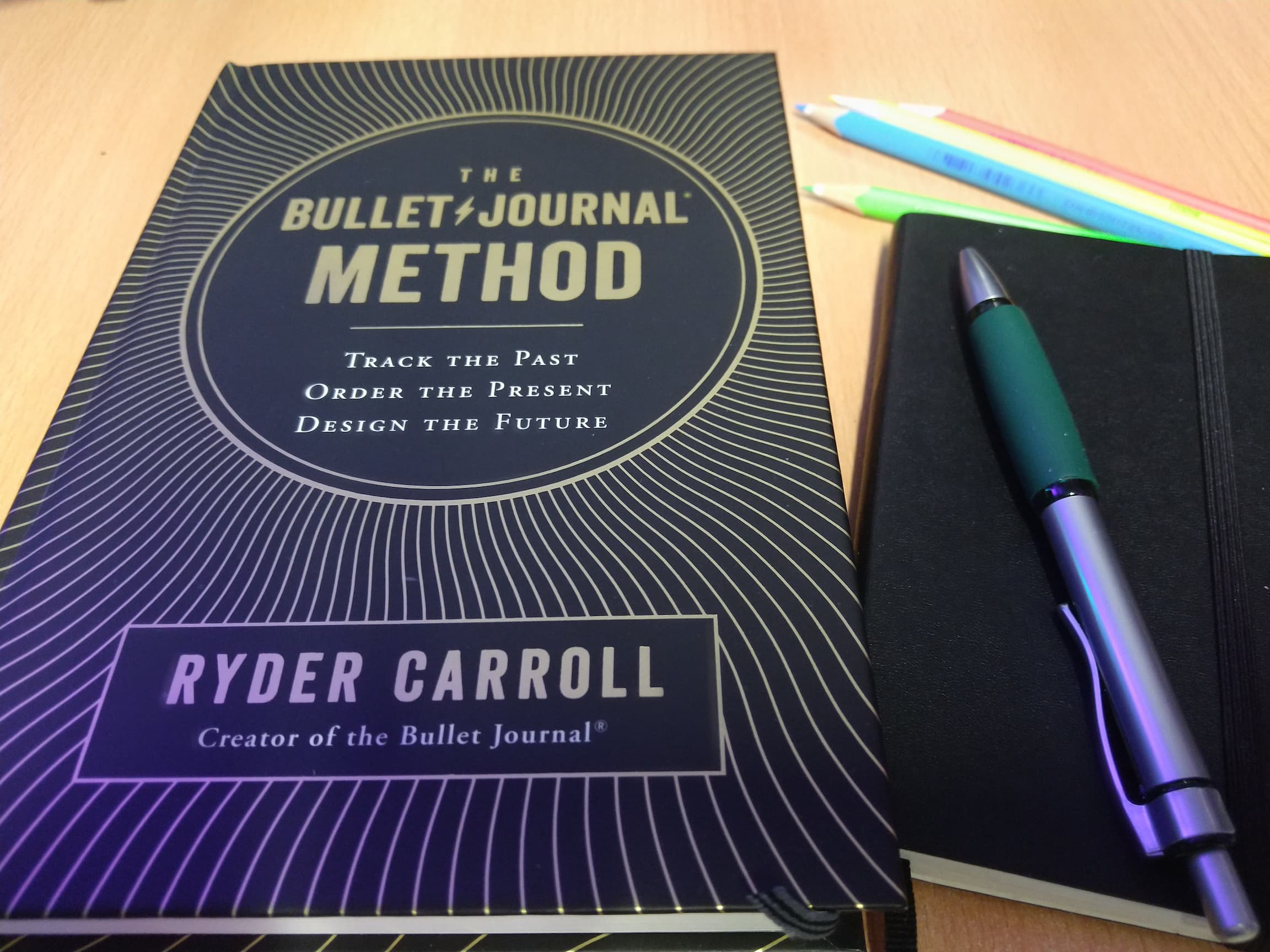Earlier this year I watched @ceos3cs video about his learning methodology. While he had a few good tips throughout the video, him mentioning that he used a paper notebook in addition to the digital recording was what got me looking at my old notebooks again.
In retrospect, I always started a paper based notebook in the harder, more stressful times of my life. One shortly before my burnout, one in the last days of my fathers life or one around the birth of our first baby. There is something soothing in writing the stuff on my mind down, but it never was a habit I kept for long. Most notebooks were at max filled to a third.
This time, I wanted a more systematic approach and in my mastodon timeline people were posting about their bullet journals for the new year. I started some research and the method seemed reasonable. But since the creator had put out a book about it, I figured I should check that out.
Presentation
The book comes in a good hardcover bind with beautiful metallic golden print. The paper is medium thick with quite a bit of texture. The typesetting is well done and it is quite easy on the eyes. Illustrations are mostly examples of journal pages or small diagrams. They are functional but also look good. Overall it is very much like you would expect of a good hardcover book.

Content
But I did not buy the book for its nice wrapping, so let’s dive into the content.
The writing is quite understandable but pleasant, comes with a touch of humor and links the scientific sources quoted. The examples used are consistent throughout the book and get reused where applicable.
Note: While you might see very elaborate Bullet Journals when searching for it online, the book reiterates several times that a bullet journal does not have to look good. It is first and foremost a functional tool and especially for beginners it is recommended to not put too much time into decorations and customizations.
Chapter 1 & 2
The first two chapters focus on the goal and origin of the Bullet Journal methodology as well as the basic technique.
Similar to other productivity techniques like “Getting things done” the Bullet Journal is meant to declutter ones mind by having all important thoughts and tasks written down. That way your mind is supposed to focus better on the task at hand.
Regular Review & Reflection phases make sure nothing important is missed and provide opportunity to question the relevance of any given task. I have encountered this base concept in many productivity techniques and it seems to be working quite well.
What sets the Bullet Journal methodology apart it it’s simple implementation and high degree of flexibility.
Basically you write down everything important during your day in short bullets. In addition you have a index to find what you need and a monthly and half yearly overview.
The flexibility comes from Custom Collections. Those can be task lists for larger projects, notes on a specific study topic or a habit tracker. The goal is to only track what is relevant, but give the room for what you are curious about or need.
After every day, you migrate unfinished tasks either to one of the collections, the monthly overview or, most importantly, strike out tasks that are not relevant or important enough. At the beginning of the day, you then review the monthly overview and your collections to make sure you do not miss anything important for the day.
A more detailed explanation of the technique can be found on the authors website: Bullet Journal.
Chapter 3
While the previous chapters explained the how, this chapter is a mix of theory behind the why and a workbook.
The author touches on why reflection is important, how to set goals and ultimately live a meaningful life. Every sub chapter comes with a exercise that will help you reflect on your life, your goals and where you want to go. It is as much a general life coaching part as it is explaining why the bullet journal works and how to get the most out of it.
This coaching part might not be for everyone. While it resonated very well with me, I could see why doing deep introspection workouts or using some of the techniques might push some people away. Doing any of them is not required to use a bullet journal but they did help me.
Chapter 4 & 5
The last chapters dive deeper into customization techniques and options. It comes with a set of examples. Some are from the author, some curated from the bullet journal community.
The book closes with an FAQ.
My Experience
This was a tough book to work through. Not so much the first part, but the second. Some of the exercises had me anxious, had me fighting with tears as they brought a lot to my mind that only had been linger subconsciously.
This was a helpful experience though. Not only did it help me focus more on my own goals again and get going with the bullet journal, my sleep issues have gotten significantly better.
What I do not have is that rush, that feeling of high productivity you usually have when starting a new productivity method. It actually is the opposite. I realize how much I have been procrastinating, how much time I spend on things not important for me.
Is this technique for me? I don’t know, that will need to get revisited in a few months.
Summary
“The Bullet Journal Method” outlines a simple, customizable technique of managing your life. You do not have to read the book to adopt the method, but it can certainly help you with that and finding out what a meaningful life means for you.

Leave a Reply